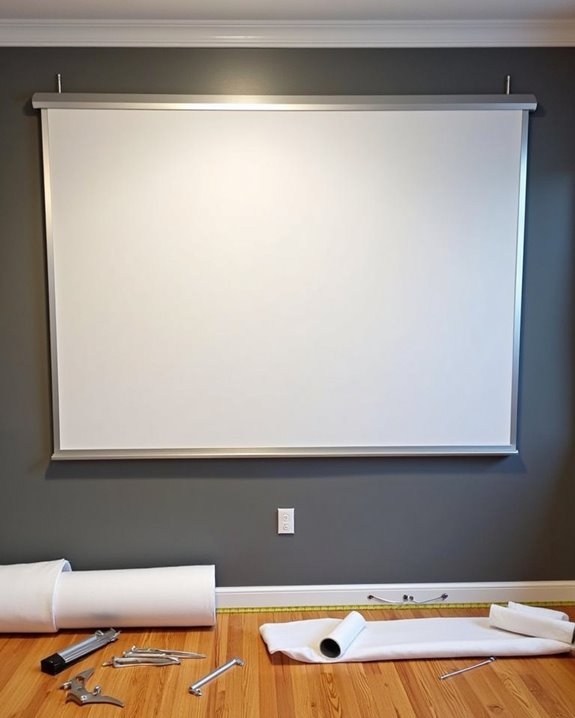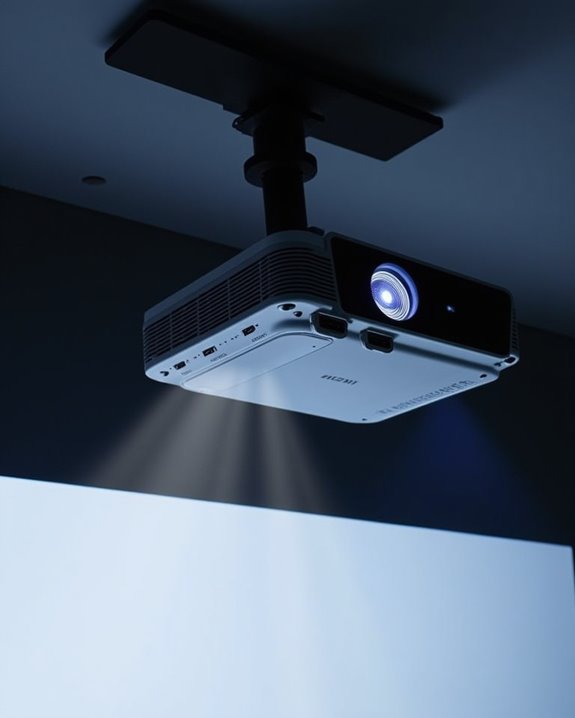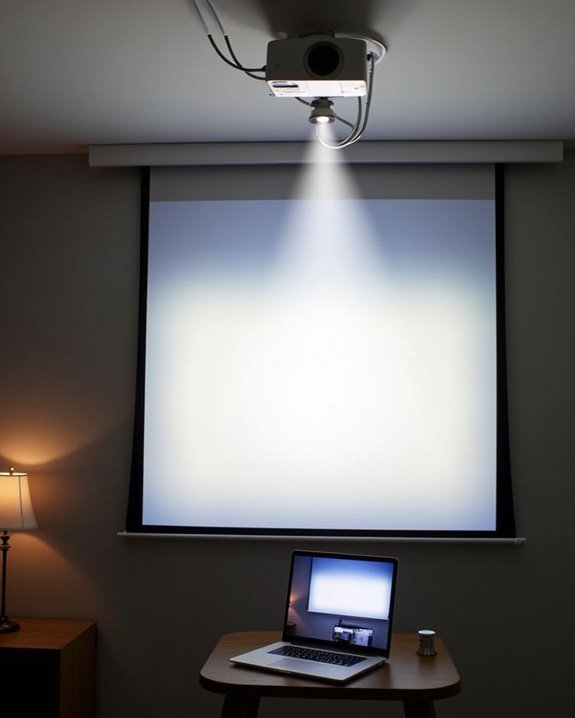The devastatingly permanent damage of a laser projector burn image can ruin your expensive equipment beyond repair. You’ve likely noticed these persistent ghost-like impressions when a static image remains displayed too long on your projection surface. Unlike temporary image retention, these burns occur when focused laser beams generate enough localized heat to physically alter screen materials, creating permanent marks that won’t fade with time. Understanding the specific causes of this phenomenon will help you protect your investment and maintain ideal image quality for years to come.
Key Takeaways
- Burn images are permanent ghost-like impressions caused by laser energy permanently damaging specific areas of a projection surface.
- These artifacts occur when concentrated laser light creates localized heating that exceeds the thermal tolerance of the projection material.
- Unlike temporary image retention, burn images don’t fade over time and appear as faint shadows resembling the original static content.
- Static content displayed for as little as 10 minutes on high-power projectors (>10,000 lumens) significantly increases burn risk.
- Preventative measures include using dynamic content, proper ventilation, pixel shifting, and avoiding excessive brightness settings.
What Is a Laser Data Projector Burn Image?
When you’re using a laser data projector, you’ll occasionally hear warnings about burn images, but what exactly are they? A burn image is a permanent ghost-like impression that remains visible on your projection surface even after turning off the projector. This damage occurs when a static image is displayed for extended periods, causing the intense laser light to permanently alter the surface materials through localized heating.
Unlike temporary image retention seen in other technologies, burn images don’t fade with time. They’re particularly common with high-powered laser projectors that generate concentrated beams of light, affecting color calibration and permanently damaging the projection substrate. The burn typically resembles the original static content’s shape, appearing as a faint shadow that interferes with future projections and degrades overall image quality. Using projectors with auto keystone correction features can help reduce static image display time by adjusting images quickly, potentially minimizing burn-in risk.
The Science Behind Laser Projector Burn Images
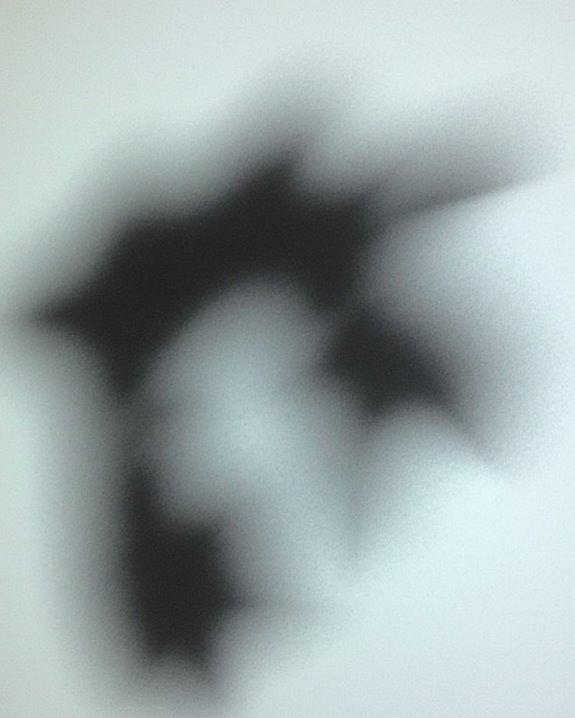
Although many users focus primarily on a laser projector’s image quality, understanding the scientific principles behind burn images can help you prevent costly damage to your projection surfaces. Burn images occur when concentrated laser wavelength energy creates localized heating that exceeds the thermal tolerance of your screen or wall. The physics is straightforward: prolonged exposure to static images allows heat to accumulate faster than thermal conduction can dissipate it.
Higher-power projectors (above 10,000 lumens) profoundly increase this risk, especially when projecting onto materials with poor heat conductivity. The damage happens at the molecular level as materials denature or chemically change under elevated temperatures. Your projection surface’s composition strongly influences susceptibility, with some materials absorbing specific laser wavelengths more efficiently, leading to faster temperature rise and permanent discoloration or deformation. Choosing projection surfaces with appropriate brightness levels and heat tolerance can significantly reduce the risk of burn images.
Common Causes of Image Retention in Laser Projectors
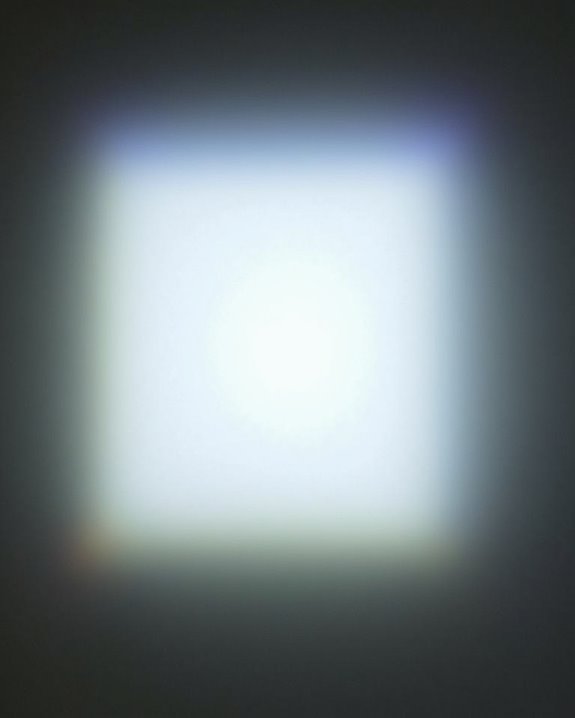
Despite today’s advanced laser projection technology, image retention remains a persistent challenge for many users. The primary culprit is prolonged static image display, where unchanging content displayed for as little as 10 minutes can initiate retention as electric charges accumulate in the liquid crystal layers. Your projector’s environmental conditions substantially impact retention risk, with high temperatures and humidity accelerating degradation, particularly when color calibration settings feature excessive brightness or contrast levels.
Manufacturing factors, including ionic impurities trapped during fabrication, create inconsistent voltage distribution across the display panel. Consistent maintenance schedules are essential for prevention, as continuous operation without proper power-down intervals prevents liquid crystals from resetting to neutral positions. Static interface elements like logos, menu bars, and unchanging presentation slides are particularly problematic when displayed without screen savers or refresh intervals. Using a projector with a sealed IP5X laser engine can help reduce dust accumulation and extend device lifespan, indirectly mitigating image retention issues.
Five Warning Signs of Potential Burn Image Formation
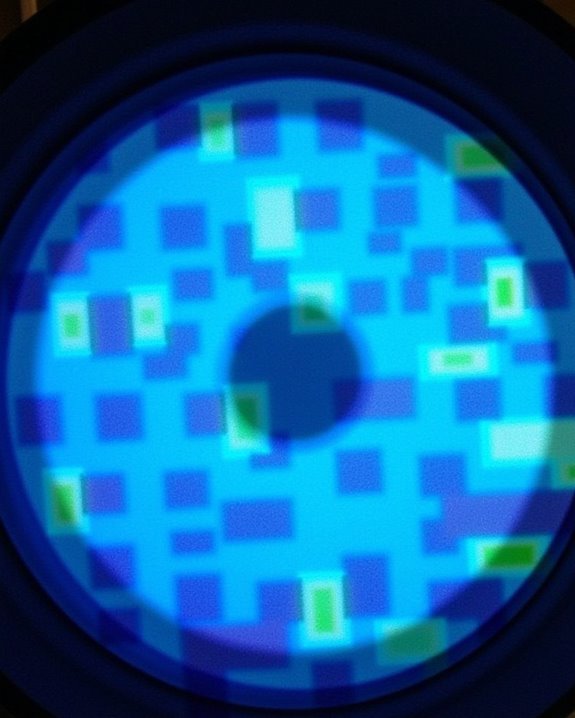
Recognizing the early warning signs of burn image formation can save you thousands in equipment replacement costs and prevent frustrating presentation disruptions. Watch for visible discoloration or color fading on your projection surface, which often appears as lighter patches that persist regardless of content changes. Ghost images or residual outlines of previously displayed content indicate serious image retention issues. Surface warping, including bubbling or texture changes in the projection area, suggests physical damage from excessive heat exposure. Be concerned if cleaning your projector’s lens and filter doesn’t resolve image problems, as this indicates burn-in has already occurred. Finally, unusual heating in specific areas of your projector may signal cooling system failures that accelerate burn image formation, requiring immediate attention to prevent permanent damage.
Preventative Measures to Protect Your Projection Equipment
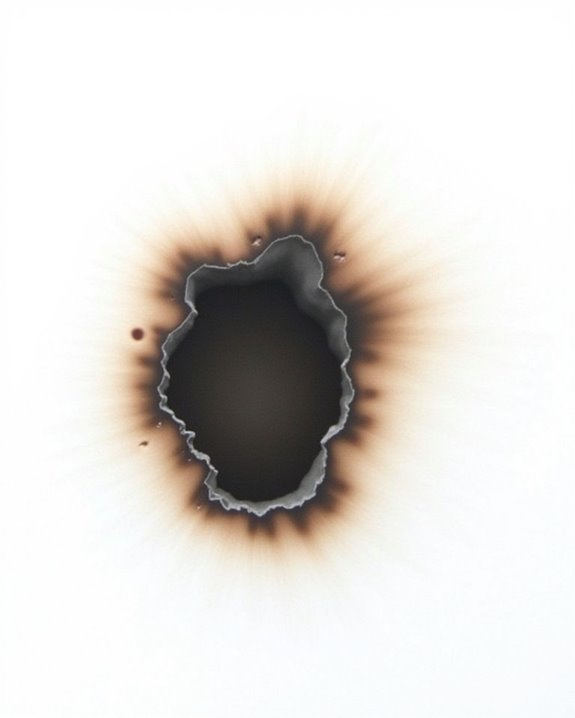
To safeguard your valuable laser data projector from burn image damage, you’ll need to implement several strategic preventative measures that considerably extend equipment lifespan. Regular lens maintenance prevents dust accumulation that can cause overheating, while color calibration ensures ideal brightness levels that reduce pixel strain.
Incorporate dynamic content whenever possible, avoiding static images that contribute to burn-in. When using fixed content, enable pixel shifting features and implement regular breaks to distribute wear evenly across the display surface. Maintain proper ventilation around your equipment, and consider utilizing screen savers during inactive periods. For long-term protection, adjust brightness settings according to your environment, perform routine burn-in tests to catch early warning signs, and activate built-in burn-in reduction modes available in modern projectors.
The Difference Between Temporary Image Retention and Permanent Burn-In
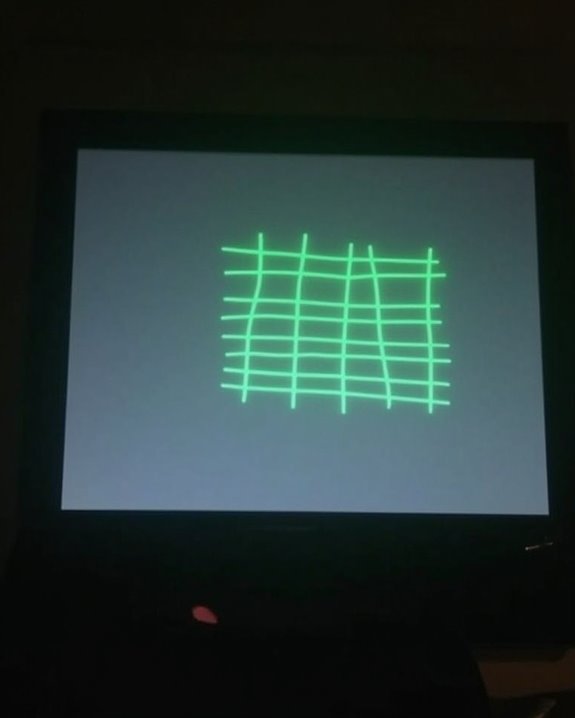
Understanding the distinction between temporary image retention and permanent burn-in will help you properly diagnose and address display issues with your projection equipment. Temporary image retention appears as a ghost image that fades within minutes to hours after changing content, while burn-in represents permanent damage that persists indefinitely. Your laser projector is considerably less vulnerable to permanent burn-in than OLED displays, which suffer from degrading organic materials. When adjusting color calibration settings, you might notice temporary afterimages, but these shouldn’t be mistaken for permanent damage. For accurate assessment, display a uniform color test pattern at high image resolution to check for lingering ghost images. Laser technology’s even light distribution and superior cooling systems make modern projectors remarkably resistant to the permanent burn-in issues that plague other display technologies.
How Environmental Factors Affect Laser Projector Performance
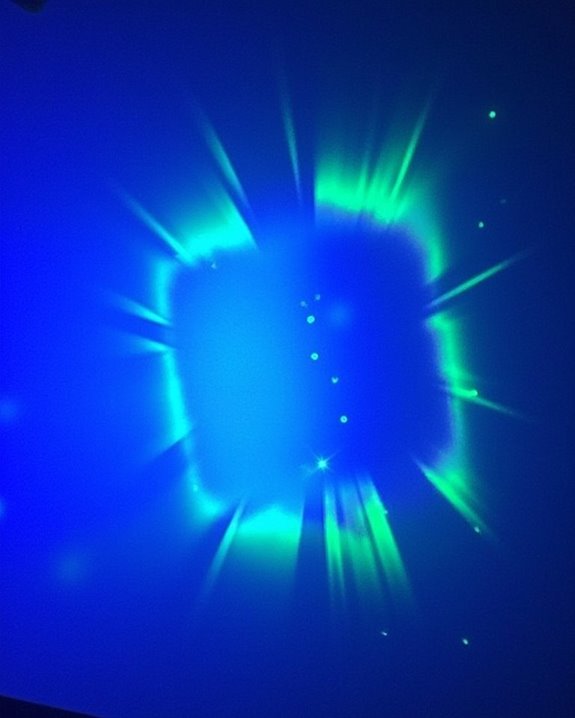
Environmental factors profoundly influence your laser projector’s performance, potentially causing temporary image issues or even permanent damage if not properly managed. Dust accumulation on optical components interferes with light transmission, reducing brightness and color accuracy while hindering proper heat dissipation, which can lead to system failure. Temperature fluctuations pose significant risks, as elevated ambient temperatures strain cooling systems and may cause overheating, compromising image fidelity through localized damage or burn-in.
High humidity levels threaten your projector’s electronics through condensation and corrosion, while poor air quality with particulates like carbon black (23%) and Arizona sand (72%) gradually degrades projection quality. Ambient light directly affects perceived contrast, and mechanical vibrations can misalign sensitive components. To protect your investment, maintain environmental conditions within manufacturer specifications and consider projectors with IP5X to IP6X protection ratings for dusty environments.
Best Practices for Commercial Laser Projector Operation

Properly managing your commercial laser projector requires adherence to specific operational protocols, ensuring both ideal performance and safety for operators and audiences alike. Start with pre-operational checklists before each session, verifying temperature and humidity levels remain within manufacturer specifications. Regular color calibration maintains image quality while preventing burn-in issues that can damage expensive components.
Implement proper power management by starting projectors at appropriate settings and avoiding sudden shutdowns, which extends lamp life and maintains brightness consistency. Never allow direct viewing of laser beams, and enforce restricted access zones with clear signage including illuminated “LASER in USE” warnings. Train all staff in emergency procedures and maintain detailed usage logs for warranty compliance. Remember that proper airflow, utilizing exhaust extraction adapters with at least 450 CFM capacity, is essential for preventing overheating and preserving *ideal* performance.
Comparing Burn Image Risk Across Different Projector Technologies
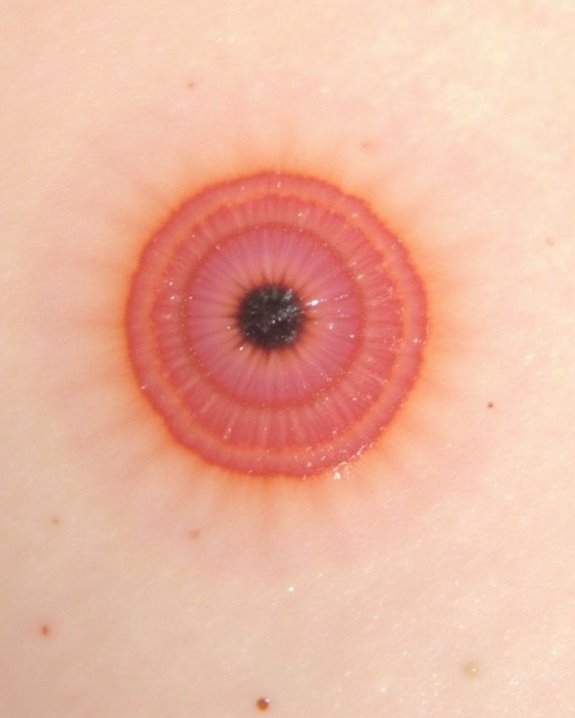
While laser projectors offer superior image quality, they present distinct burn image risks compared to alternative projection technologies. Unlike lamp-based projectors that distribute heat more broadly across surfaces, laser systems concentrate energy into precise points, potentially causing localized burn damage even with proper color calibration. LED projectors generally pose the lowest risk due to their cooler operation, while hybrid laser-phosphor systems strike a middle ground in terms of burn potential.
Power management becomes critical with high-lumen laser projectors (10,000+ lumens), as their focused beams can rapidly exceed surface thermal tolerance when projecting static content. You’ll find lamp projectors generate more overall heat but with less concentrated intensity, resulting in gradual screen degradation rather than the sharp, defined burn images characteristic of laser technology.
Remediation Techniques for Existing Burn Damage
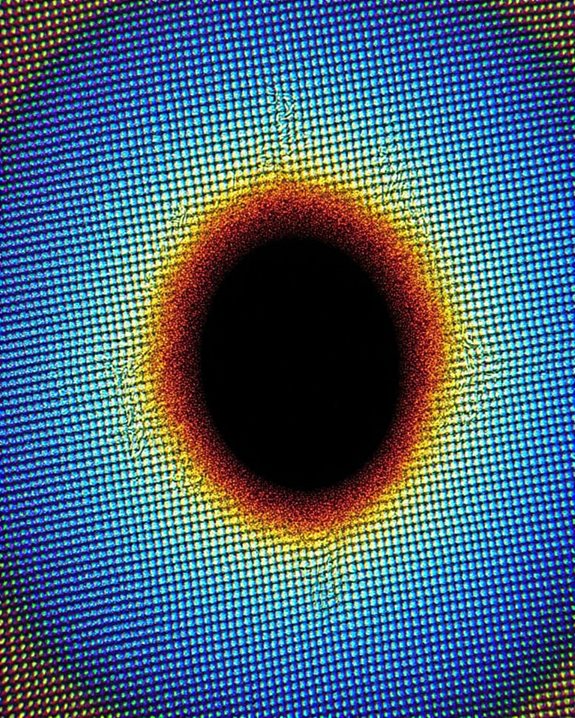
When existing burn damage occurs in your laser data projector’s image, you’ll need to implement targeted remediation techniques to restore ideal display quality. Begin with basic cleaning tips, using a soft, lint-free cloth to gently clean the lens, as dust accumulation can mimic burn spots and exacerbate existing damage. Regular maintenance of fans and air filters improves ventilation, preventing the overheating that worsens burn-in issues.
For persistent problems, consider component upgrades as a more definitive solution. Replace aging lamps that may intensify burn image effects, or consult professionals about repairing damaged circuitry and DMD chips. Utilize built-in features like image shifting to distribute pixel wear evenly, and adjust brightness settings to reduce component stress. For severe cases, professional remediation from authorized service centers offers specialized repairs beyond DIY capabilities.
Frequently Asked Questions
Can Laser Projector Burn Images Be Removed With Specialized Software?
No, you can’t remove true laser burn images with software. They’re physical damage affecting screen durability, not temporary image persistence. Only hardware repair or component replacement can address permanent laser-induced pixel damage.
Do Warranty Policies Typically Cover Burn Image Damage?
Like falling on a warranty landmine, burn image damage usually isn’t covered. You’ll find warranty exclusions classify it as user-induced damage, and coverage limitations typically apply to manufacturing defects, not improper usage patterns.
How Quickly Can Burn Images Form in High-Brightness Settings?
In high-brightness settings, burn image formation can occur within hours. You’ll notice faster damage when your projector’s at maximum power. High brightness impact accelerates the process, especially with static content on susceptible screens.
Are Certain Screen Materials More Resistant to Burn Images?
Yes, you’ll find screens with higher material resistance markedly reduce burn image risk. Specialized laser-ready screens with heat-dissipation properties offer better screen durability than standard materials, particularly those with thermal-resistant coatings or substrates.
Can Burn Images Transfer Between Multiple Projection Surfaces?
Like a tattoo that stays only on one skin, burn images don’t transfer between projection surfaces. You’d need specialized image transfer techniques, as projection surface compatibility doesn’t allow burns to migrate naturally between materials.


